If you’re looking for the best wireless guitar systems for 2025, I recommend models that offer reliable, interference-free performance with clear sound and long battery life. Systems like the Xvive A58 and Fender Telepath stand out for their durability, excellent range, and quick setup features. Many support multiple channels and come with charging options, making them perfect for stage use. Keep exploring further to find the perfect fit for your style and needs.
Key Takeaways
- Look for systems with 5.8GHz digital transmission to ensure interference-free, high-fidelity sound during performances.
- Prioritize models with long-range capabilities (over 100 feet) and true diversity design for stable, uninterrupted connectivity.
- Choose wireless systems supporting multiple devices simultaneously and quick pairing features for versatile stage setups.
- Opt for units with rechargeable batteries offering at least 4-7 hours of operation and easy USB or Type-C charging options.
- Consider durability, compatibility with electric guitars or bass, and additional accessories like antenna kits for optimal reliability.
JOYO Wireless Guitar System with Charging Box
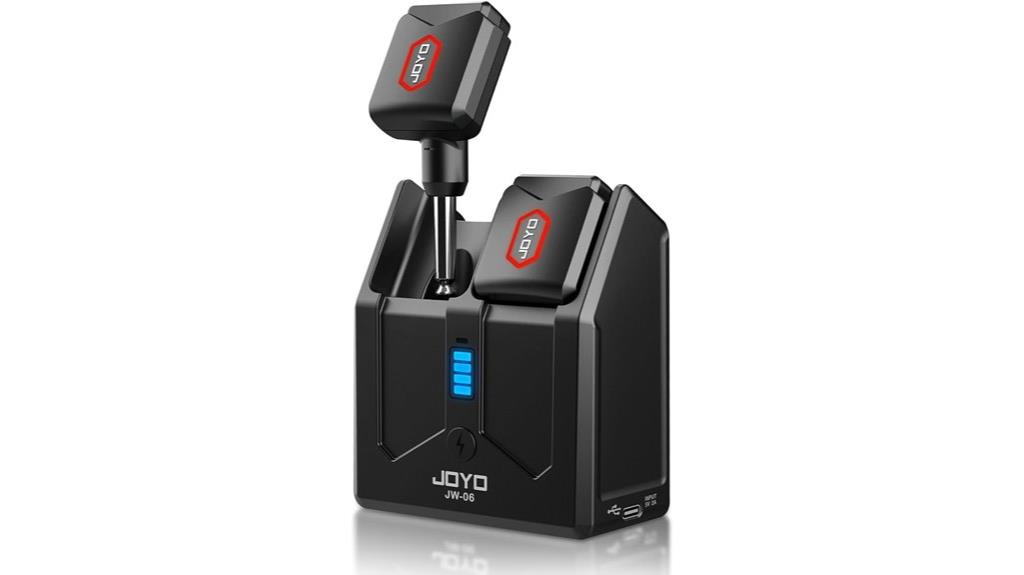
If you’re looking for an affordable and reliable wireless solution for live gigs or practice sessions, the JOYO Wireless Guitar System with Charging Box is a great choice. It operates on the 5.8GHz band, ensuring a stable, low-noise connection with minimal latency. The portable charging box doubles as a power source, providing up to 6 hours of continuous use per charge. Compatible with most electric guitars and basses, it features four signal channels and easy pairing. Weighing just 8.4 ounces, it’s lightweight and user-friendly. Overall, it offers solid performance at a budget-friendly price, making it ideal for practice, rehearsals, and small performances.
Best For: musicians seeking an affordable, reliable wireless guitar system for practice, rehearsals, or small live performances.
Pros:
- Stable 5.8GHz connection with low noise and minimal latency
- Compact, lightweight design with a portable charging box offering up to 6 hours of use
- Compatible with most electric guitars and basses, supporting four signal channels for multiple connections
Cons:
- Susceptible to Wi-Fi interference on the 5.8GHz band, requiring channel adjustments
- Low maximum input voltage can cause hard clipping during vigorous playing
- Output stage instability may lead to oscillations or potential device failure
LEKATO Wireless Guitar System (Black)

Looking for a reliable wireless guitar system that delivers clear, high-quality sound without breaking the bank? The LEKATO Wireless Guitar System (Black) operates at 5.8GHz, providing stronger anti-interference and stable connections up to 150 feet. Its compact, lightweight design fits most electric guitars and basses, with a 220° rotatable plug for versatility. The system supports 24-bit 48KHz audio, ensuring crisp sound with minimal latency. Users praise its quick pairing, solid build, and affordability—often compared favorably to higher-end brands. With rechargeable batteries lasting around five hours and simple plug-and-play operation, LEKATO offers a dependable, noise-free experience for live gigs and practice.
Best For: musicians and guitarists seeking an affordable, reliable wireless system with high-quality sound and easy setup for live performances or practice.
Pros:
- Supports 24-bit 48KHz audio for clear, high-fidelity sound.
- Easy plug-and-play operation with quick pairing and stable connection up to 150 feet.
- Compact, lightweight design compatible with most electric guitars, basses, and electric-acoustic instruments.
Cons:
- Some users report issues with battery charging or unit malfunctions.
- On/off switches may be less smooth to operate.
- Rechargeable batteries may need replacement over time, though the system is designed for longevity.
Fender Telepath Wireless System, Mystic Ice Blue and Black

The Fender Telepath Wireless System, Mystic Ice Blue and Black, stands out as an ideal choice for performers who need reliable, full-frequency wireless audio across stage distances. It transmits via a 5.8GHz digital signal, avoiding crowded 2.4GHz bandwidth for fewer interruptions. Features like auto pairing, an articulating input plug, and an active/passive switch make setup quick and versatile. With up to 70 feet of range, low 4ms latency, and multi-unit pairing, it handles multiple instruments seamlessly. Designed for both active and passive instruments, it delivers natural tone with minimal interference, earning positive reviews and strong market presence. It’s perfect for professional, hassle-free stage performances.
Best For: professional musicians and stage performers seeking reliable, full-frequency wireless audio with quick setup and minimal interference.
Pros:
- Delivers clear, full-range sound with low latency for natural playing feel
- Easy to set up with auto pairing and articulating input plug
- Supports multi-unit pairing for seamless instrument transitions and stage management
Cons:
- Limited to a 70-foot range, which may not suffice for very large venues
- Slightly higher price point compared to basic wireless systems
- Requires 5.8GHz compatible devices, potentially limiting older equipment compatibility
Wireless Guitar System with 6 Channels and Rechargeable Transmitter/Receiver

A wireless guitar system with 6 channels and a rechargeable transmitter and receiver is ideal for live performers and serious musicians who need reliable, interference-free sound. It offers high-quality, stable audio with minimal latency and supports over 20 meters of transmission distance, making it perfect for stage performances and practice. The plug-and-play design features a 280° rotatable plug compatible with most electric guitars, basses, and digital instruments. Its rechargeable battery lasts at least 6 hours after a quick 2-hour charge via USB-C. Supporting up to 6 devices simultaneously without interference, it simplifies setup and ensures uninterrupted, clear sound during your performances.
Best For: musicians and live performers seeking a reliable, interference-free wireless guitar system with multi-channel support and long-lasting rechargeable batteries.
Pros:
- Supports up to 6 channels simultaneously, preventing interference during performances
- Over 20 meters transmission range ensures freedom of movement on stage
- Plug-and-play setup with a 280° rotatable plug for broad device compatibility
Cons:
- Cannot access AMP function during use, limiting certain effects
- Requires a 2-hour charge for at least 6 hours of operation, which may be inconvenient during quick setups
- May be less suitable for environments with multiple wireless systems due to potential minor interference if not properly managed
Xvive A58 Wireless Guitar System (5.8GHz)

For guitarists seeking reliable wireless performance on stage or at home, the Xvive A58 Wireless Guitar System stands out with its true diversity design and 5.8 GHz operation, which helps prevent interference and dropouts. It supports both active and passive pickups, making it versatile for all guitars and basses. The system delivers high-resolution 24-bit/48 kHz audio within a 20Hz-20kHz range, with a range up to 100 feet. Easy channel management includes a scan mode for selecting the best frequency, and the USB-C charging offers around 5 hours of playtime. It’s a simple, dependable solution for unrestricted playing.
Best For: guitarists and bass players seeking a reliable, interference-free wireless system compatible with all instrument types for live performances or practice.
Pros:
- True diversity design ensures stable, interference-free signal transmission
- Supports both active and passive pickups, offering versatile compatibility
- Long-lasting battery life with quick charging and up to 5 hours of use
Cons:
- May require manual channel matching after scan for optimal performance
- High-input levels on passive pickups might cause distortion unless switched to active mode
- Limited to 5.8 GHz frequency, which may be crowded in some areas
Shure GLXD16+ Digital Wireless System with Pedal Receiver for Guitar & Bass

If you’re a guitarist or bassist seeking reliable wireless performance, the Shure GLXD16+ Digital Wireless System with Pedal Receiver stands out as an excellent choice. It offers automatic pairing, dual-band operation in 2.4GHz and 5.8GHz, and seamless channel switching to prevent dropouts. With up to 12 hours of rechargeable battery life and quick 15-minute charging, you can perform worry-free all night. The system includes a premium cable and supports up to 16 channels with optional accessories like the Frequency Manager. Its compact, metal design and 100-foot range make it perfect for live performances, ensuring clear, interference-free sound every time.
Best For: musicians, particularly guitarists and bassists, seeking reliable wireless performance with long battery life and interference-free operation.
Pros:
- Automatic pairing and seamless channel switching prevent dropouts during performances
- Dual-band operation in 2.4GHz and 5.8GHz enhances bandwidth and reliability
- Up to 12 hours of rechargeable battery life with quick 15-minute charge for extended use
Cons:
- Not compatible with previous GLX-D or GLX-D Advanced Wireless models
- Accessories like the Frequency Manager and antenna kits are sold separately
- Limited to small to medium installations; may require additional equipment for larger setups
Shure BLX14 UHF Wireless System for Guitar and Bass

Looking for a reliable wireless system that delivers professional sound with minimal setup? The Shure BLX14 UHF Wireless System is an excellent choice for guitar and bass players. It features a simple setup with a single-channel receiver and bodypack transmitter, plus accessories like cables and batteries. With up to 14 hours of battery life and a range of 300 feet, it offers great mobility on stage. Its ability to scan for clear channels minimizes interference, and it supports expansion up to 12 channels per band. Users praise its clear audio, durability, and ease of use, making it a dependable solution for both small venues and larger performances.
Best For: guitar and bass players seeking a reliable, easy-to-use wireless system with professional sound quality for small to large stage performances.
Pros:
- Simple setup with automatic channel scanning and internal gain control.
- Long battery life of up to 14 hours and a range of 300 feet for mobility.
- Supports up to 12 channels per band, ideal for multi-mic setups and expanding systems.
Cons:
- Bodypack clip may be prone to popping off easily.
- Analog transmission could be less resistant to interference compared to digital systems.
- Requires regional frequency verification to ensure compatibility and optimal performance.
Shure GLXD14R+ Wireless System for Guitar and Bass

The Shure GLXD14R+ Wireless System stands out as an excellent choice for musicians and presenters who need reliable, interference-free wireless connectivity for guitar and bass. It features dual-band technology in 2.4GHz and 5.8GHz, automatically selecting clean channels to prevent dropouts. With up to 12 hours of battery life and quick charging, you’re ready to perform without interruptions. The system supports up to 16 channels with optional frequency management, ensuring smooth operation even in crowded environments. Its easy setup, automatic pairing, and robust digital audio quality make it ideal for small to medium gigs, giving you confidence on stage.
Best For: musicians and presenters seeking a reliable, interference-free wireless system for guitar and bass performances in small to medium venues.
Pros:
- Dual-band technology with automatic channel selection ensures dropout-free audio and minimizes interference.
- Up to 12 hours of battery life with quick charging increases operational flexibility.
- Easy setup with automatic pairing and spectrum monitoring simplifies use for live performances.
Cons:
- Not compatible with previous GLX-D or GLX-D Advanced models, limiting upgrade options.
- Supports only one channel per system, which may require additional units for multiple instruments.
- May require optional accessories for larger multi-channel setups or specific configurations.
Xvive A58 Wireless Guitar System with 5.8GHz Transmitter and Receiver

The Xvive A58 Wireless Guitar System is an excellent choice for musicians who need reliable, high-quality wireless connectivity without sacrificing tone. Operating at 5.8GHz, it avoids interference from Wi-Fi and household devices, ensuring a stable signal. With over 100 feet of range and tested outdoor distances up to 150 meters, you can move freely across the stage or room. The system offers zero latency, maintaining perfect timing, and features quick channel search for effortless pairing. Its transparent sound quality preserves your tone, and with up to 5 hours of battery life, it’s perfect for gigs and rehearsals. Overall, it’s a dependable, affordable option for performers seeking freedom from cables.
Best For: musicians who need a reliable, high-quality wireless system for live performances, rehearsals, or studio use without sacrificing tone or experiencing interference.
Pros:
- Operates at 5.8GHz for stable, interference-free signal transmission
- Over 100 feet of reliable range with up to 150 meters outdoors
- Zero latency and transparent sound quality preserving original tone
Cons:
- Basic LED indicators provide limited visibility of battery status
- Slightly limited charge level indicators, requiring attention to battery life
- Compact design may require careful handling to avoid disconnection during vigorous use
Line 6 POD Go Wireless

For guitarists who need mobility without sacrificing tone, the Line 6 POD Go Wireless stands out as an ideal choice. Its lightweight, compact design (just over 9 inches by 14 inches and weighing about 8 pounds) makes it easy to carry on stage. The unit features a simple interface with a large color display, a rugged cast-aluminum expression pedal, and a built-in Relay wireless system with the Relay G10TII transmitter. Drawing from the HX family, it offers over 270 amp, cab, and effects models, plus support for third-party IRs. Its versatile connectivity and built-in audio interface make it perfect for both live performances and studio recordings.
Best For: guitarists seeking a portable, versatile effects processor with wireless capability for live gigs and studio use.
Pros:
- Lightweight, compact design for easy portability and stage use
- Extensive tone library with over 270 amp, cab, and effects models, plus third-party IR support
- Built-in Relay wireless system for improved mobility during performances
Cons:
- Slightly higher price point compared to simpler multi-effects units
- Limited to the features and models available within the HX family and IR loading options
- May require some time to fully explore and customize the extensive settings and effects
Positive Grid Spark NEO Wireless Guitar Amp & AI-Powered Guitar Rig

If you’re a guitarist seeking a versatile and high-quality practice and performance tool, the Positive Grid Spark NEO Wireless Guitar Amp & AI-Powered Guitar Rig stands out. It combines advanced AI-driven features, custom audio drivers, and noise-isolation for an immersive sound experience. With Bluetooth streaming and a wireless transmitter, I can easily connect my devices with ultra-low latency. The smart app offers instant tone creation, chord learning, and song emulation, making practice more engaging. Plus, the six-hour battery life ensures hours of uninterrupted jamming. Overall, it’s a compact, powerful solution that elevates both practice sessions and live performances.
Best For: guitarists seeking a versatile, high-quality practice and performance tool with advanced AI features and seamless connectivity.
Pros:
- Combines AI-powered tools for instant tone creation, chord learning, and song emulation
- Offers noise-isolation with custom drivers and ultra-soft ear cups for immersive sound
- Wireless Bluetooth streaming with ultra-low latency and up to 6 hours of battery life
Cons:
- May be more expensive than standard practice headphones or amps
- Limited to Bluetooth connectivity, which might cause interference in crowded environments
- Requires a compatible smartphone app for full functionality, which may involve a learning curve
Upgrade 2.4GHz Wireless Guitar System with Rechargeable Battery
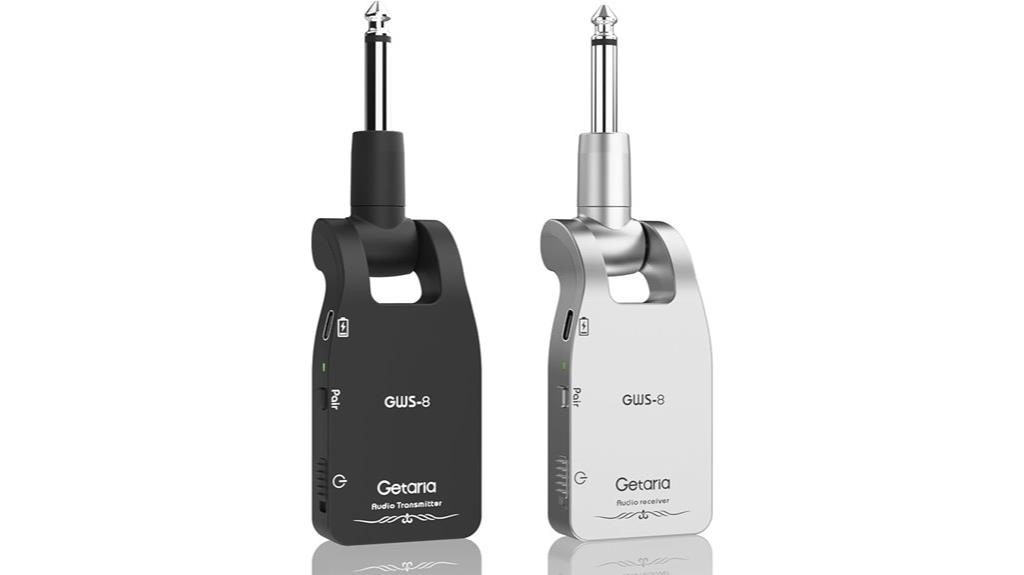
Musicians demanding reliable, long-lasting wireless connectivity will find the upgraded 2.4GHz Wireless Guitar System with a rechargeable battery to be an ideal choice. Designed for electric guitars, bass, and similar instruments, it supports six devices simultaneously without interference. Its 24bit / 48KHz digital transmission ensures high-fidelity sound with low latency, over an effective range of 30 meters. The rotatable 1/4 inch plug offers flexible positioning, while the built-in 750mAh rechargeable battery provides hours of performance. Fully charged in about 1.5 hours via Type-C, it’s simple to set up—factory pre-paired for quick use, perfect for live gigs.
Best For: Professional and amateur guitarists, bassists, and performers seeking reliable, high-fidelity wireless connection for live performances and practice sessions.
Pros:
- Supports up to six devices simultaneously without interference for versatile use.
- High-quality 24bit / 48KHz digital transmission ensures clear, professional-grade sound.
- Long-lasting rechargeable 750mAh battery with quick 1.5-hour charging for extended performance time.
Cons:
- May require initial pairing setup for new users despite factory pre-pairing.
- Effective range of 30 meters might be limited in large or complex stage environments.
- Compatibility limited to electric guitars, bass, and similar instruments; not suitable for acoustic-only setups.
SWIFF Wireless Guitar System with Rechargeable Transmitter and Receiver
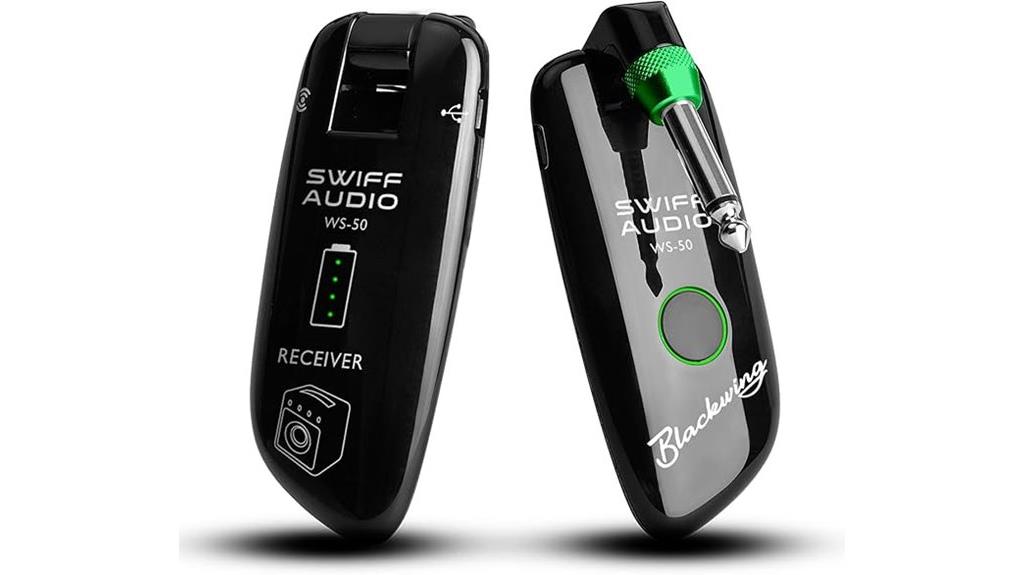
The SWIFF Wireless Guitar System with Rechargeable Transmitter and Receiver stands out as an ideal choice for performers who need reliable, high-quality wireless transmission without the hassle of frequent battery replacements. Its sleek design features a 220° rotatable plug for easy pairing and plug-and-play operation, compatible with most electric guitars. Utilizing advanced UHF wireless technology, it offers a long range of up to 164 feet with minimal latency and no signal loss. The rechargeable lithium-ion batteries provide around 5 hours of continuous use, with quick charging and a clear battery status display. Overall, it combines durability, versatility, and excellent sound fidelity for seamless stage performances.
Best For: Musicians and performers seeking a reliable, high-quality wireless guitar system with long-range capability and easy setup for live performances.
Pros:
- Supports up to 100 channels for multiple device use and minimal interference
- Long transmission distance of up to 164 feet with no signal loss or lag
- Rechargeable batteries offer approximately 5 hours of continuous use with fast charging
Cons:
- May be more expensive than wired alternatives or less advanced wireless systems
- The plastic build, while durable, might be less rugged than metal counterparts over time
- Limited to 20 KHz frequency response, which might not satisfy the most audiophile users
5.8GHz Wireless Guitar Transmitter and Receiver System with Charging Box

For performers seeking a reliable wireless solution, the GHz Wireless Guitar Transmitter and Receiver System with Charging Box offers an excellent combination of clear audio, low latency, and extended battery life. It supports up to 6 hours on a full charge, with the charging box providing an additional 12 hours of power. The system features stronger anti-interference, low noise, and latency under 6ms, ensuring seamless performance. Its stable 15-20 meter range and multi-receiver pairing make it versatile for various instruments like guitars, basses, and keyboards. Compact and lightweight, it’s designed for easy setup, making it ideal for gigs, rehearsals, and on-the-go playing.
Best For: musicians and performers seeking a reliable, low-latency wireless guitar system with extended battery life for live gigs, rehearsals, and on-the-go playing.
Pros:
- Supports up to 6 hours of use on a single charge with an additional 12 hours from the charging box
- Low latency under 6ms with clear, high-quality audio transmission
- Easy plug-and-play setup with stable 15-20 meter range and multi-receiver pairing capabilities
Cons:
- Non-rotatable jack may limit certain instrument connections
- Occasional reports of receiver power issues after prolonged use
- Slightly larger size compared to ultra-compact wireless systems
BOSS WL-20L Wireless Guitar System Transmitter and Receiver
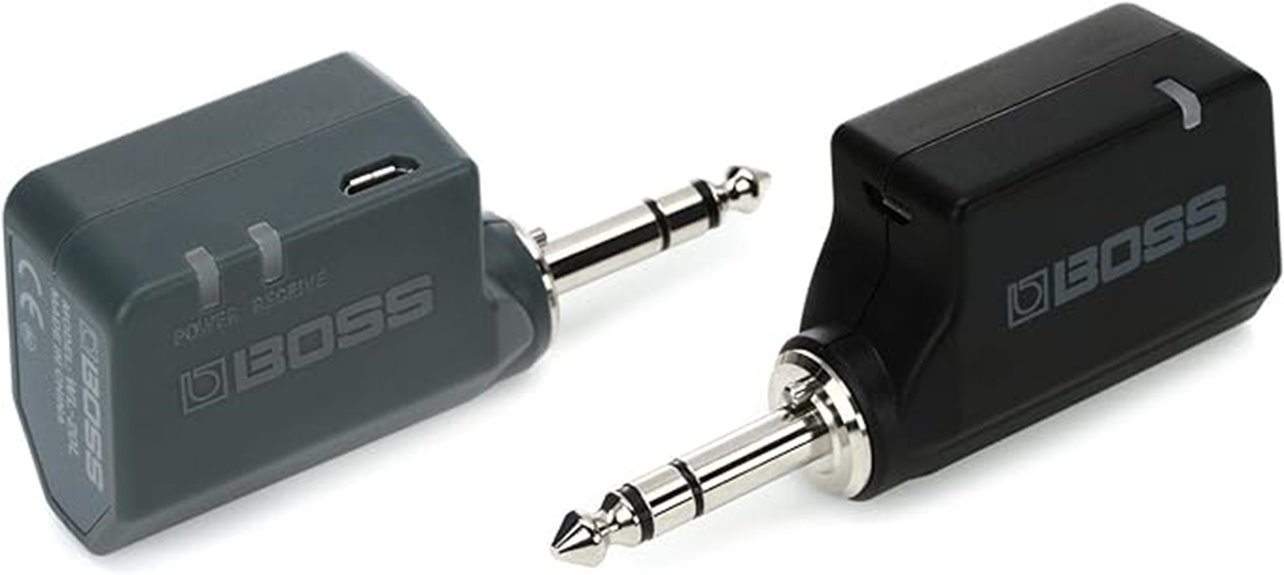
If you’re looking for a reliable wireless solution that offers high-quality sound with minimal latency, the BOSS WL-20L is an excellent choice. This compact, plug-and-play system is perfect for acoustic and electric guitars, basses, and electronic instruments. It features advanced BOSS technology, automatic channel selection from 14 options, and easy setup. With USB charging, it provides around 7 hours of use, eliminating cables and enhancing stage freedom. Users praise its stable connection, clear audio, and low latency (~2.8 ms), making it ideal for gigs, rehearsals, and performances. While some minor interference issues exist, it remains a top-tier, gig-ready wireless system.
Best For: musicians seeking a dependable, high-quality wireless system for live performances, rehearsals, and gigging with active or passive instruments.
Pros:
- Reliable, stable connection with minimal interference and clear audio quality
- Low latency (~2.8 ms) suitable for live playing and recordings
- Easy to set up with automatic channel selection and USB charging for long battery life
Cons:
- Limited to 14 automatic channels, which may cause interference in crowded environments
- Some users experience difficulty turning units off or charging issues
- Compatibility issues with certain active pickups or specific guitar models may require workarounds
Factors to Consider When Choosing Wireless Guitar Systems
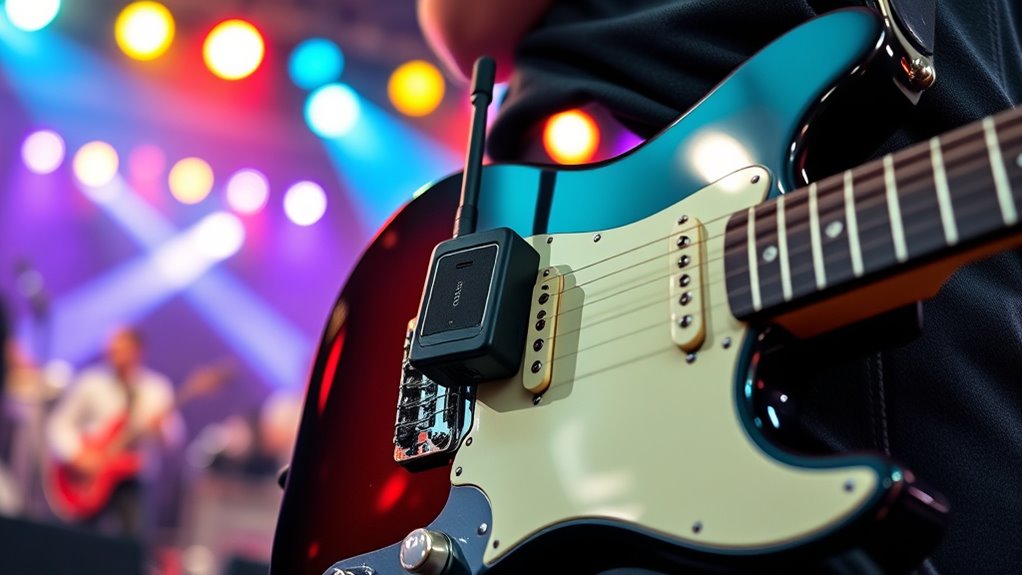
When choosing a wireless guitar system, I consider factors like the frequency it operates on, battery life, and how far it can transmit. I also look at whether it’s compatible with my instruments and if the latency and sound quality meet my needs. These points help guarantee I get a reliable system that suits my playing style.
Wireless Frequency Selection
Choosing the right wireless frequency for your guitar system is essential to guarantee a reliable and interference-free performance. The two main options are 2.4GHz and 5.8GHz bands, each with its pros and cons. The 2.4GHz band is more common, but it’s also crowded with Wi-Fi, Bluetooth, and other devices, increasing the risk of signal dropouts. On the other hand, 5.8GHz offers less congestion and higher bandwidth, resulting in more stable connections and fewer disruptions. The environment plays a big role; crowded venues benefit from 5.8GHz systems, while smaller or less congested settings might work fine with 2.4GHz. Some advanced systems support dual-band operation, automatically switching frequencies to optimize stability and minimize interference.
Battery Life Duration
Battery life duration plays a significant role in how well a wireless guitar system performs during gigs or practice sessions. It determines how long I can play without worrying about recharging or swapping batteries. Most systems offer between 4 to 7 hours of runtime on a full charge, which is typically enough for most performances. Rechargeable batteries with longer life spans are especially convenient, reducing the need for frequent recharging during extended gigs. Quick-charging features are also a bonus, giving me several hours of use after just a short charge, minimizing downtime. An accurate battery level indicator is essential, allowing me to monitor remaining power and avoid unexpected shutdowns mid-performance. Overall, choosing a system with reliable, long-lasting battery life ensures uninterrupted playing and peace of mind on stage.
Signal Range Capacity
Signal range capacity is a crucial factor because it determines how far I can move on stage or practice without losing connection. Most wireless guitar systems offer ranges from about 15 to over 100 feet, depending on the model and environment. Non-line-of-sight capabilities can extend the effective range, letting me perform through walls or obstructions. However, interference from Wi-Fi, Bluetooth, or other wireless devices can affect stability and reduce range. Higher-end systems tend to provide longer, more reliable coverage suitable for large stages or outdoor gigs. It’s important to remember that the maximum advertised range isn’t always the real-world performance; obstacles and signal congestion often limit how far I can truly go without dropouts. Choosing a system with adequate range helps guarantee uninterrupted performances.
Compatibility With Instruments
When selecting a wireless guitar system, guaranteeing compatibility with my instrument is essential to prevent connection issues and maintain sound quality. I check that the system’s input connector matches my instrument’s jack type, usually 6.35mm mono. If I have active pickups, I look for systems that support high input levels to avoid distortion, or I choose passive-compatible models. I also verify the frequency band—2.4GHz or 5.8GHz—to ensure it fits my environment and gear. The transmitter’s plug design and rotation angle matter too, especially for my playing style and jack position. FINALMENTE, I confirm the system’s impedance and maximum input voltage match my instrument’s output, preventing signal clipping or loading issues during performance.
Latency and Sound Quality
Choosing a wireless guitar system isn’t just about compatibility; it also depends heavily on latency and sound quality. Low latency, ideally under 6 milliseconds, is essential so that my playing feels immediate, with no noticeable delay between my fingers and what I hear. High sound quality is equally important, with a signal-to-noise ratio above 100dB, ensuring the audio remains clear and free from background noise. Digital systems often excel here, offering better fidelity and lower latency than analog options, making them ideal for live and studio use. However, interference from Wi-Fi or other wireless devices can cause dropouts or distortion, so a stable, consistent connection is critical. Prioritizing these factors helps me deliver seamless performances with pristine sound.
Ease of Setup
Ease of setup is a vital factor that can make or break your experience with a wireless guitar system. A system with automatic pairing features simplifies the process by connecting devices instantly when powered on, saving you time and frustration. Systems that support one-click or quick setup procedures allow you to get your instrument ready to play in seconds, which is essential during live performances. Plug-and-play compatibility minimizes configuration, making it accessible for both beginners and pros. Clear indicator lights or prompts guide you through pairing and setup, reducing confusion and errors. Additionally, systems built with stable connection protocols and minimal steps help prevent technical delays. Overall, a wireless system designed for effortless setup ensures you spend less time troubleshooting and more time performing confidently.
Frequently Asked Questions
How Do Wireless Guitar Systems Affect Overall Sound Quality?
Wireless guitar systems can impact sound quality, but when chosen carefully, they provide clear, uninterrupted audio. I notice that high-quality systems minimize latency and noise, ensuring my tone stays true to the original. Modern digital tech has considerably improved this, so I rarely experience dropouts or interference. Overall, if you pick reliable gear, wireless systems enhance your performance without sacrificing sound quality, giving you freedom to move on stage.
What Are the Best Practices for Minimizing Latency?
Think of latency as a hiccup in a conversation; it disrupts the flow. To minimize it, I keep my firmware updated and choose systems with low latency specs. I also position the receiver close to my guitar and use high-quality batteries. Turning off unnecessary wireless devices helps reduce interference. Practicing with my setup ensures I stay in sync, making my performance seamless and responsive.
How Secure Are Wireless Signals Against Interference?
Wireless signals are generally pretty secure against interference, especially with modern systems that use advanced encryption and frequency hopping. I always choose systems with robust security features to prevent signal hijacking or disruption. Still, I keep my gear away from other wireless devices, and I regularly update firmware to guarantee maximum security. Staying vigilant helps me perform confidently without worrying about unexpected signal interference.
Can Wireless Systems Run on Batteries for Extended Gigs?
Yes, wireless systems can run on batteries for extended gigs. I’ve used mine for several hours without needing a recharge, thanks to high-capacity batteries designed for long performances. While some worry about power loss, investing in systems with good battery life and carrying spares guarantees uninterrupted play. Plus, many units have low power consumption, so you can perform confidently knowing your wireless system will keep up with your set.
What Maintenance Is Required to Ensure System Longevity?
To keep my wireless guitar system lasting, I regularly check and replace batteries, clean connectors, and update firmware. I also store it in a cool, dry place and avoid extreme temperatures. Periodic inspections help catch any issues early, preventing failures during gigs. Proper maintenance ensures reliable performance, minimizes interference, and extends the lifespan of my gear so I can focus on playing without worries.
Conclusion
Choosing the right wireless guitar system is like finding the key to your musical soul—freeing you to express without limits. As you pick your perfect match, remember it’s more than tech; it’s a bridge to your creativity, a trusted companion on your stage journey. When you find that connection, every note becomes part of a greater melody—your symphony of freedom and passion. Let your choice unseal endless possibilities and elevate your performance.










